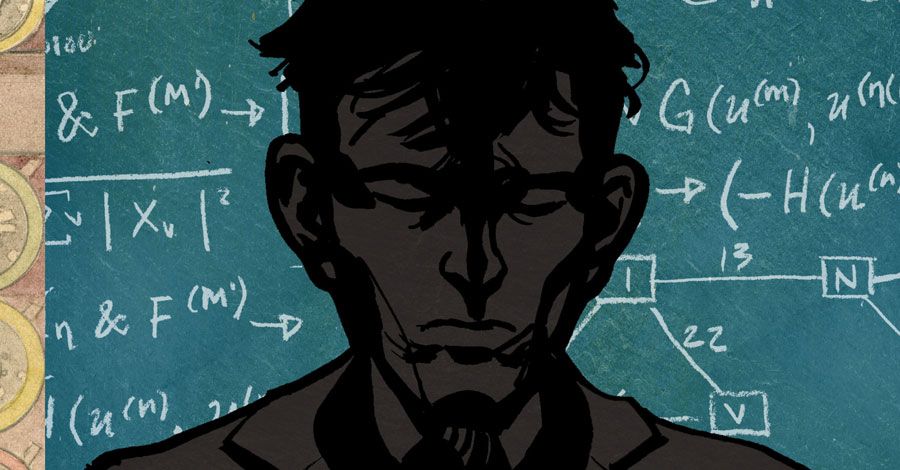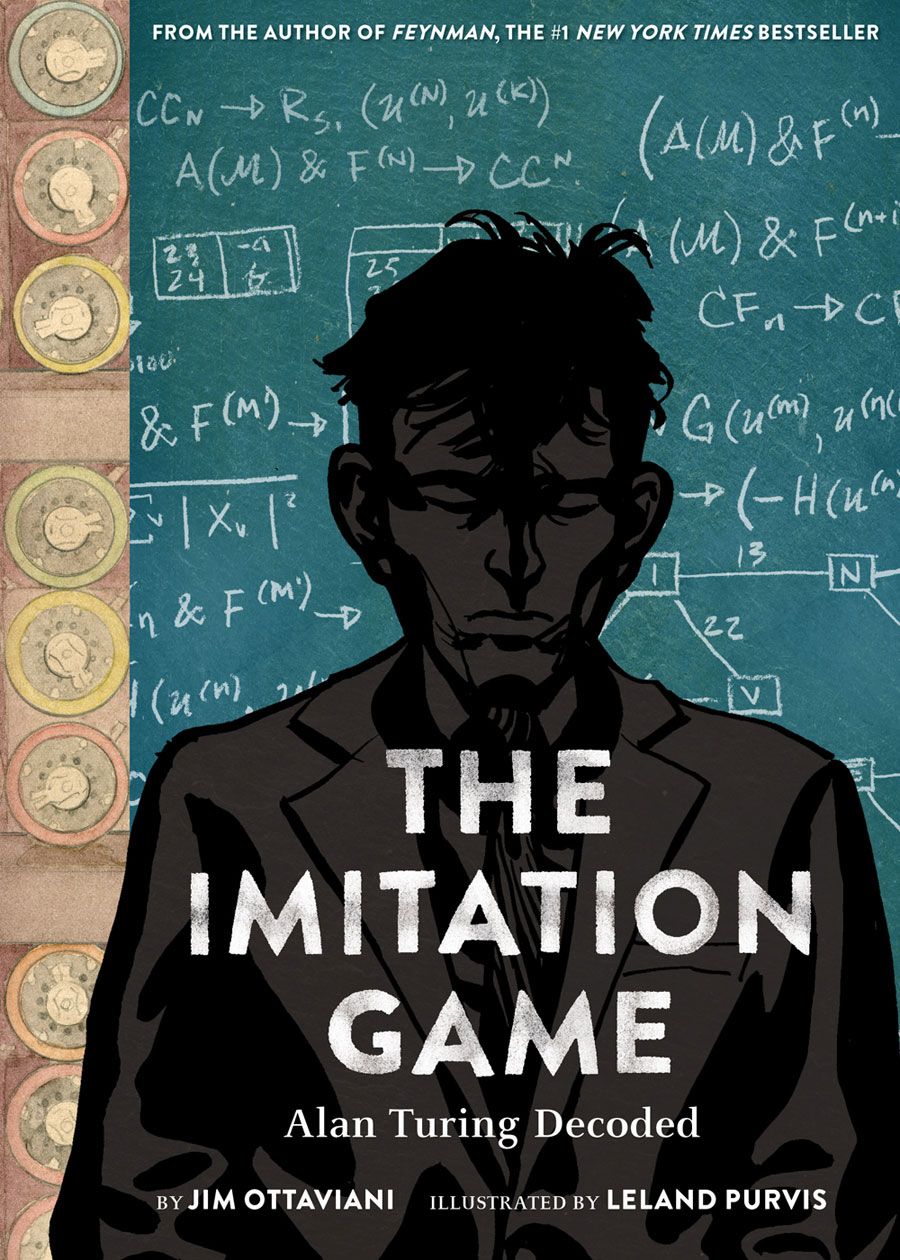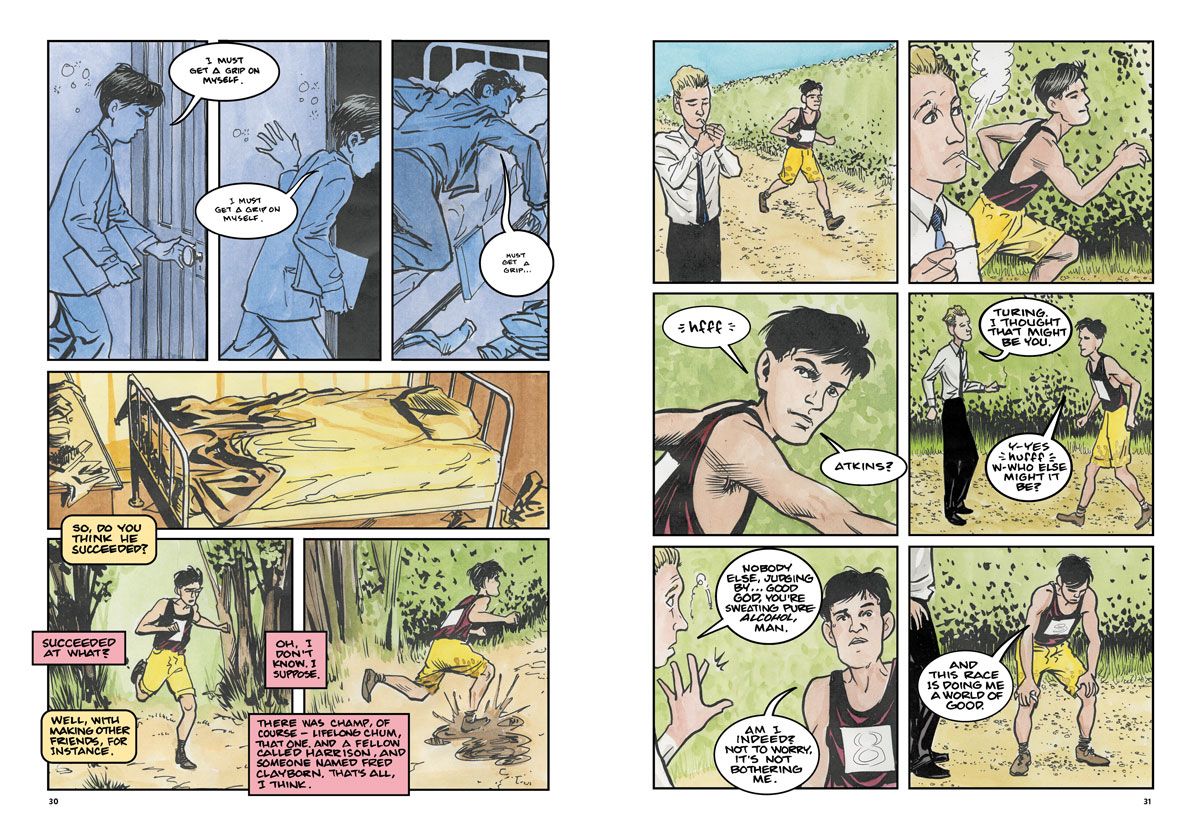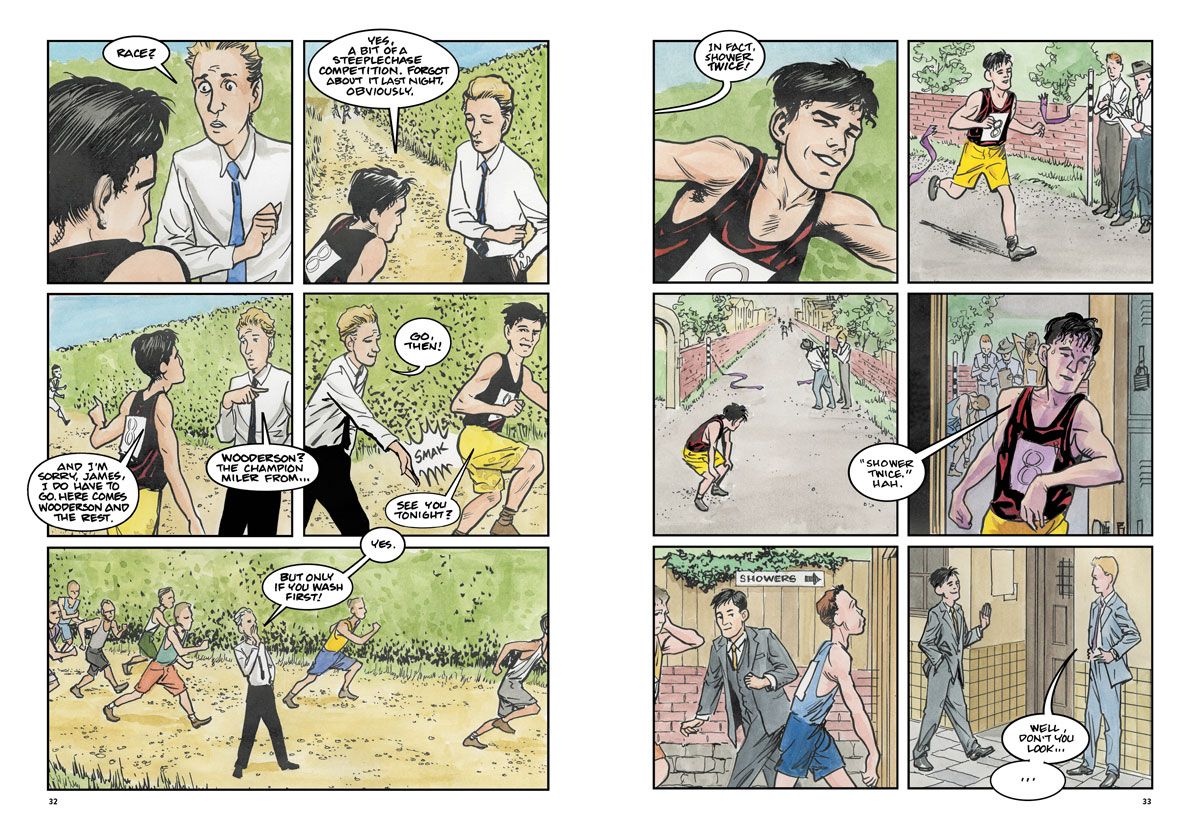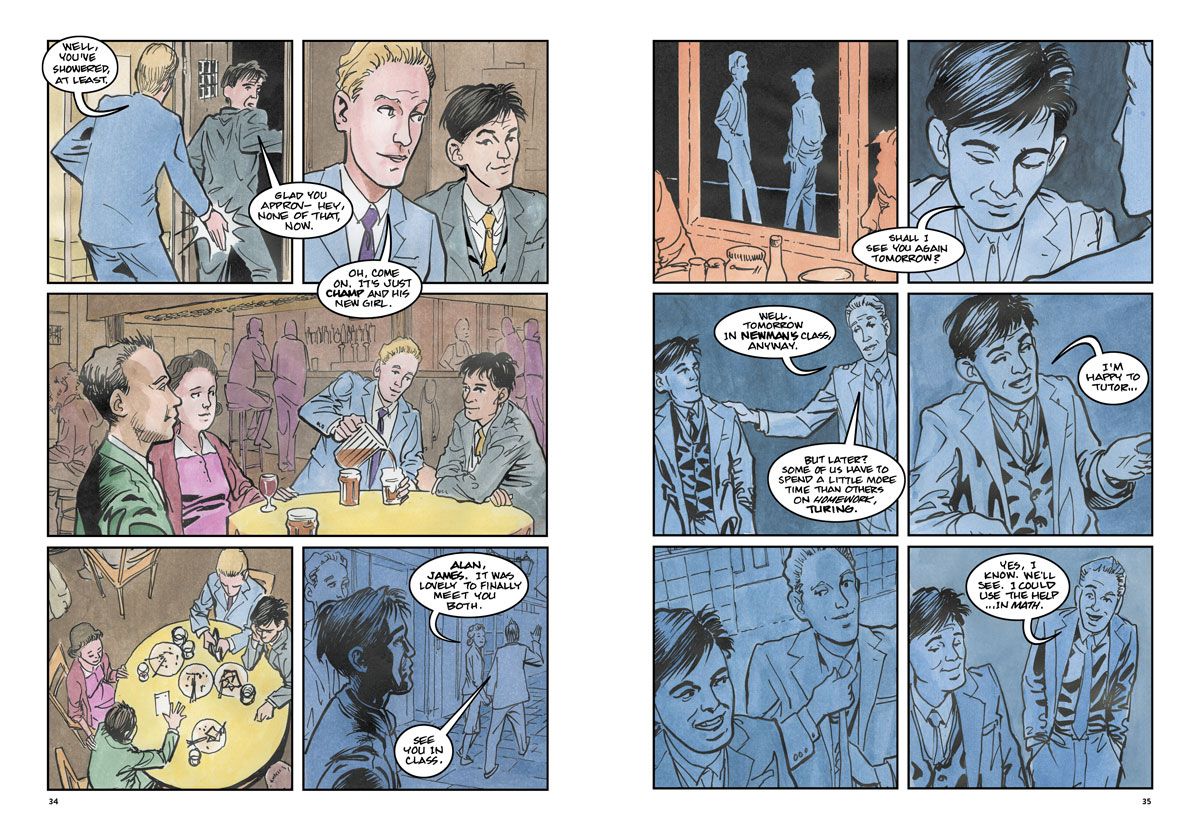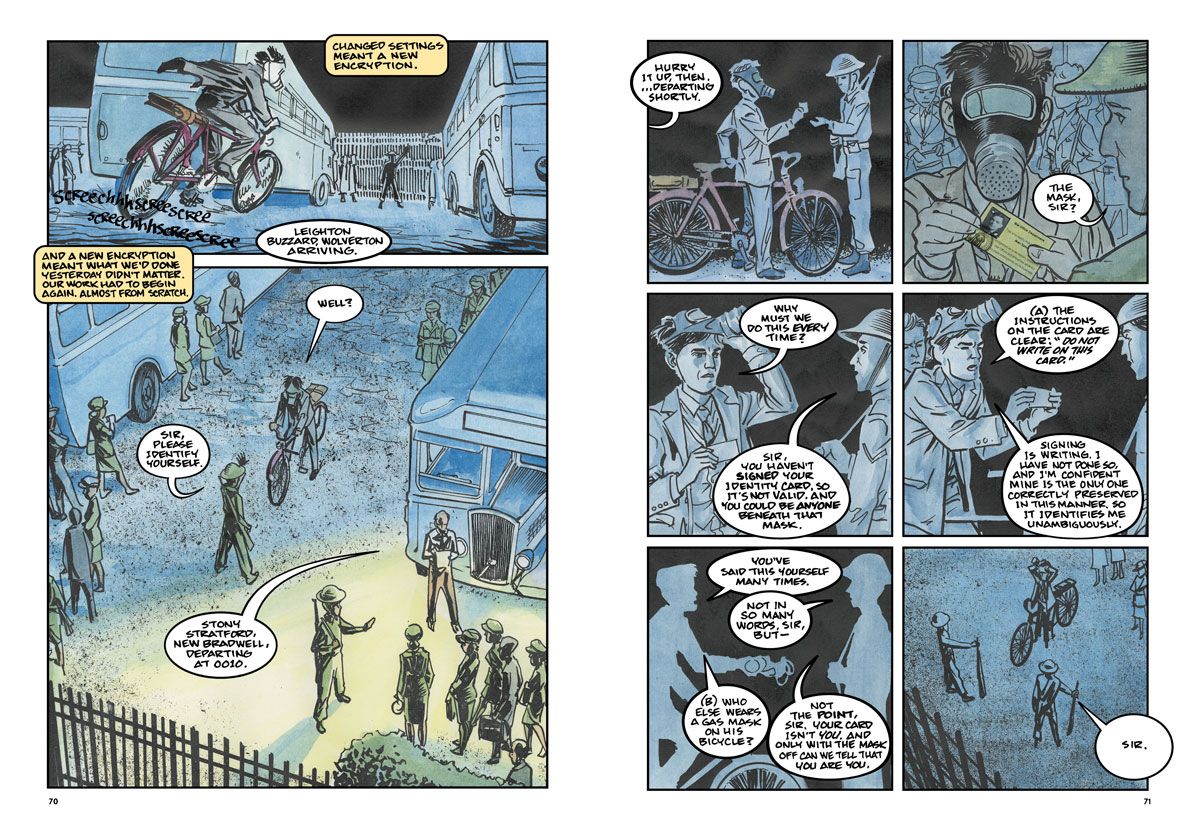Jim Ottaviani has spent much of his career in comics telling the real life stories of scientists, inventors and thinkers who have shaped and reshaped our world. In books like "Primates," "Feynman" and others, he's looked at people's lives and their work, using the comics form to find a way to communicate their complex and influential ideas. His latest book, a collaboration with Leland Purvis, is "The Imitation Game: Decoding Alan Turing." Ottaviani and Purvis have worked together in the past on the book "Suspended in Language," about Niels Bohr, and in their new book, they two have turned their gaze to another giant of the 20th Century.
Alan Turing was a key figure in the development of computing technology, helped to crack the Enigma code during WWII, and created the standard test for artificial intelligence, which remains known as the Turing Test. He was also openly gay at a time when that was illegal, leading him to being convicted of homosexual acts and chemically castrated before dying at the age of 41. In the past decade,Turing received an official apology from British Prime Minister Gordon Brown and a posthumous pardon from the Queen due to playing a key role in the Allied victory in WWII and saving countless lives -- neither of which mattered in the 1950s. For those who only know Turing through the many fictionalized portraits of him in film and books and as a tragic figure who died far too early, "The Imitation Game" reveals Turing to be not just a rare genius, but a world class athlete, and a colorful, eccentric figure at ease with himself -- even if others weren't.
CBR News: What is it about Alan Turing that you found so interesting you created a graphic novel about him?
Jim Ottaviani: Turing was a mathematician, and computer scientist before that phrase meant anything to any but a few people. He was a world-class runner, gay and kind of a slob. He invented the basic architecture of modern computers (the Universal Turing Machine), the gold standard test for artificial intelligence (the Turing Test), and was a code-breaking war hero for the British during World War II.
Without him, this bright glowing square you're reading from right now might not exist at all.
That's an exaggeration, but not much of one. It's simply an indication of how hard it is to overestimate Turing's influence on computers as we know them.
Leland Purvis: The challenge for me with Turing, which is what made him interesting, was trying to find ways to convey elements of his complex character, visually. He was enormously confident in his thinking and abilities, yet in other ways surprisingly clueless. This sets up a dichotomy, a tension, that lends well to thematic movement. Searching for ways to explore that tension visually was a treat.
For people who don't know, what was the Government Code and Cypher School at Bletchley Park and what did they do?
Ottaviani: The GC&CS was formed during World War I, and its official function was "to advise as to the security of codes and cyphers used by all Government departments and to assist in their provision." It also, secretly, worked on breaking codes used by other governments. Most of its work during World War II got done at Bletchley Park, and that's where Turing and his group succeeded in breaking the famous German Enigma machine, among other codes. In short, by delivering close to real-time intelligence on German military (especially naval) operations, the code-breakers at Bletchley Park saved countless lives, and no doubt shortened the war, probably by years.
One aspect of Bletchley Park I find fascinating is the fact that this group of people cracked the Enigma code, made huge strides in computing. Then, after WWII ended, everything was destroyed and they were told to never say anything about what they did. It was all a secret for decades. That seems nuts.
It's hard to imagine, isn't it? Having nobody talk about these amazing accomplishments, for decades, is so implausible that it sounds like fiction to people used to minute-by-minute social media updates and all the oversharing we're addicted nowadays. I mean, it's much easier to imagine this:
@BletchleyDude Cracked Enigma today, will shorten war by years IMHO. #SuckItNazis #YoureWelcomeUSA
...followed by a Vine of one of the Bombes clattering away.
Anyway, they kept the secret so well that there's a story told about some Bletchley alums meeting up with their German counterparts many years later (and after relations had improved immensely, of course) and the Germans saying something to the effect of "Well, at least you never broke Enigma." To which, the British code-breakers just smiled and changed the subject. It wasn't until the 1970s that the achievements of the Bletchley crew became public knowledge.
Purvis: There's a trace of shame about it. Shame is attached to secrecy in a way. As individuals, most of the things we keep secret have some shame attached. So I read the dismantling of Bletchley as a cultural reaction to shame as an aspect of secrecy. The counter-example that Turing provided personally was also cautionary. He wasn't ashamed of his sexuality, and so didn't keep private about things the culture at the time would have preferred. And they punished him for it, tragically.
You portray Turing as scruffy, casual. Bletchley Park was very unconventional, but was he seen as an odd figure by his contemporaries?
Ottaviani: Many of the code-breaking wizards were odd. Minor spoiler alert: there's a scene in the book where Churchill notes that all these boffins -- one of my favorite words, but probably too unfamiliar to modern readers -- are not the usual sort of person you'd pick to help win a war. Among themselves, though, they probably thought, "He's so strange; good thing I'm normal."
The best perspective on this comes from the memoirs of Wrens. These Women's Royal Navy Service personnel did a lot of the dirty work, both physically and intellectually, at Bletchley Park. And yeah, they pretty much thought all of the boffins were weird.
One thing that was fascinating is that Turing was an insane cyclist and an Olympic level runner and actually tried out for the 1948 Olympics?
Ottaviani: I'm not sure that's how I'd describe his cycling, but now that you say it I guess you can make the case for that. He sure was careless and didn't maintain his bicycle very well. As for the running, it's amazing, isn't it? It's like finding out that Jane Goodall wrote a bunch of hit singles for Motown under a pseudonym or something-these days we just don't expect our scientific geniuses to be good at anything else.
The two of you have pages where Turing is explaining his ideas to real people, interactions with historical figures. How much time did you spend trying to figure out how to portray that, who he should talk to, how it should look?
Ottaviani: Who he talks to is actually well-grounded in the real world. He either interacted with all those people intellectually via building on their work, or he wrote about them in his own papers. The article in which he describes what we now call the Turing Test is full of (imagined) arguments with hypothetical objectors to the notion that machines could ever think.
I write a full script, so I spent a lot of time figuring out the staging of these sequences and how the story should flow. So I can share some of the credit for how these work, but not the majority. The script posed some real challenges for Leland, and he called me out on my hair-brained ideas more than once. And then he figured out a way to make things work.
Purvis: Jim is really brilliant as a comics writer, being able to think of how to tell a story visually. It's even more important in a book where some of the ideas are complex or subtle, or just plain esoteric. In the few cases where I had to send up a flare, it usually had to do with staging, and with the transitions from 'real' scenes to symbolic ones where some of the harder thinking needed to be explained in a fun way, as clearly as possible.
Leland, how difficult was it to get visual reference for everything in the book?
Purvis: Any artist who works with Jim starts with an embarrassment of riches. As a science-librarian, he has access to gobs of reference material which arrived to me in the form of about a 3/4" thick stack of Xeroxes and a disc of additional photographs and even a few historical videos. (Even an audio file of what the bombe machines sounded like when they ran.) That said, it's often hard to know what you're going to need. Jim's stuff ended up being about a third of it, and I had to supplement the rest with my own research. Sometimes that was uniform insignia, sometimes a particular building, a historical figure, or interior shots of a U-boat. Whenever you're trying to do accurate history visually, the reference gets hip-deep pretty fast.
The book's subtitle is "Alan Turing Decoded." I'm curious what you meant by that.
Ottaviani: The subtitle for this book gave us a lot of trouble, to tell you the truth. One of my favorites was "The Imitation Game: Alan Turing, Computing Machinery, and Intelligence" which says it all, and incorporates the actual title of the paper where he introduced the game itself. It almost made the cut, but for reasons I don't remember we ended up scrapping that one, spending a lot of time with a thesaurus and doing word association, and landed on the one you now see on the cover.
The idea behind it is to signal to readers that this book will bring you inside the life and work of Turing, and explain why he's one of the most important figures in the world of computer science. I hope we've accomplished that by showing Turing in all his intellectual glory, the times in which he lived, and the very human problems that result when a man of genius and integrity keeps secrets he's promised to keep, is honest in the face of injustice, and then deals with the consequences head on.
Leland, I wondered if you could talk a little about how you use color in the book, because it really is striking.
Purvis: Wow, well, a lot of ways, and some that don't show up as well at this stage. I started with a palette that I thought lent itself to the time period. Dyes that go well with wool were big in the pre-War era, so you're looking at a lot of Payne's Grey and Yellow Ochre. Burnt Sienna. Warm and cool grays.
After that, I ventured into looking at some pieces with a thematic eye. Yellow/gold was my code for scientific thinking, Apollonian. Lab rooms were often yellow, math papers, Turing's tie, a random boffin's teacup. On the other side was feeling, Dionysian thinking, so the code was wine-reds, emotional, romantic. The color coding is reflected in the captions as well, with one being more clinical and detached, the other more involved and descriptive.
Generally, the colors get subtly less vibrant and the pages go on. More varied and slightly brighter in the beginning, then less saturation if you will, and eventually a bit more monochromatic as the themes turn darker and more troubling.

